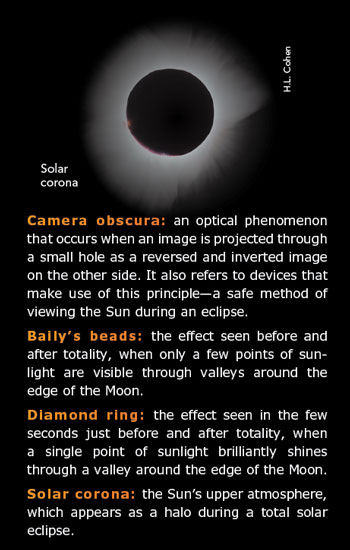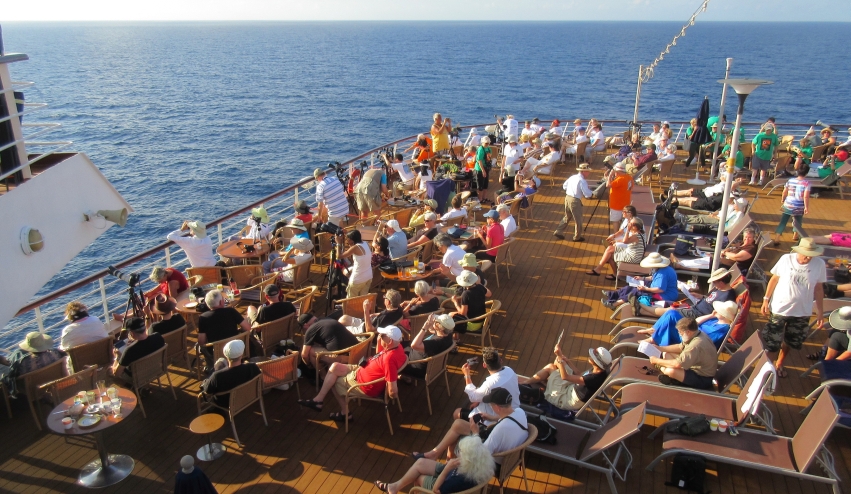This August, a narrow band across the United States will experience two minutes and 40 seconds of total darkness.
What would be your reaction if you learned that by some magical force, Victoria Falls was going to be moved from Zambia, in southeast Africa, to St. Louis? Folks in the Midwest could enjoy one of the Seven Natural Wonders of the World for an afternoon… an experience that would otherwise prove nearly impossible due to the remoteness of its location.
Wouldn’t you want to go? How could you pass up the opportunity of a lifetime? Well, that’s the opportunity we’re about to have on August 21st, when the path of a total solar eclipse passes over southern St. Louis and Carbondale—a trajectory spanning the entire continent, from Oregon to South Carolina.
A Majestic Experience
A total solar eclipse, which can only be seen from within the narrow path of totality, is truly a natural wonder. Because it’s not easy to see one, few appreciate the majesty of such an event. Many think that a partial eclipse is almost as good. In Peoria, the Sun will be 93% covered. Some conclude that that means the experience will be nearly as good as seeing the total eclipse. Not true! The experience here in Peoria will be perhaps five percent what those in the path of totality will experience.
Consider the difference between seeing a photograph of an ice cream cone… and actually eating it. That’s the difference between seeing a partial eclipse and experiencing a total eclipse. As retired NASA astrophysicist Fred Espenak (mreclipse.com) has said, “A total eclipse of the Sun is simply the most beautiful, stunning and awe-inspiring astronomical event you can see with the naked eye.”
The experience is memorable, unquestionably on par with any of the consensus Seven Wonders of the Natural World (a list which usually includes Mount Everest, Victoria Falls, Rio de Janeiro Harbor, the Grand Canyon, the Great Barrier Reef, the Paricutin volcano and the Aurora Borealis). Having seen six of the Seven Wonders, I feel fully qualified to make that assessment.
There are so many aspects to the experience leading up to totality: the slow, eerie darkening of the sky; the natural camera obscura effect, projecting the partial phases thousands of times over; the effect on birds and other animals, reacting as if it’s sunset; the shadow approaching across the landscape, Baily’s beads and the diamond ring effect.
At totality, the black hole in the sky is enveloped by the brilliant solar corona, against a nighttime sky, surrounded by stars and planets, and a stunning 360-degree sunset. At the end of totality, everything happens again, but in reverse!
In the Shadow of the Moon
That’s why I’ve traveled around the world to catch these few minutes of totality. To date, I’ve been in the shadow of the Moon for a bit over 17 minutes, while observing six total eclipses from four continents: 1970 in Newport News, Virginia; 1990 in Helsinki, Finland; 1991 in Mazatlán, Mexico; 1999 near Munich, Germany; 2001 in a remote portion of northwest Mozambique, Africa; and in 2016, aboard the MS Volendam in the Makassar Strait of Indonesia.

Watching the Indonesia eclipse, 2016
The March 9, 2016 total eclipse in Indonesia was my most memorable. It was the first time I had a chance to share the experience with over 1,000 fellow eclipse-chasers. This is important, since there’s also a human element to the eclipse experience. It’s exhilarating to be around others, sharing the experience, engaging in pre-eclipse festivities, waiting with bated breath for the clouds to move away, and collectively cheering each dramatic moment leading up to totality. All this on a two-week journey to some of the most exotic ports in the world.
We’re so lucky to live on the Earth. Were it not for a remarkable coincidence, eclipses would not happen here, nor be as spectacular as they are. The Sun just happens to be 400 times the diameter of the Moon, and it also happens to be 400 times further away than the Moon. The result is that the Sun and Moon appear to be the same angular size in the sky. If it was any other ratio, a solar eclipse might be unremarkable—a shoulder-shrug, if it happened at all.
When it’s all over, you may want to have a tissue or handkerchief handy, because the experience is so powerful and beautiful that many who experience one are brought to tears of excitement and joy at the wonder of nature they’ve just experienced. a&s
Sheldon Schafer retired as the Director of Education and Planetarium Curator at the Peoria Riverfront Museum in 2014, and now holds the title of Director Emeritus. He has taught astronomy at Bradley University since 1980.


